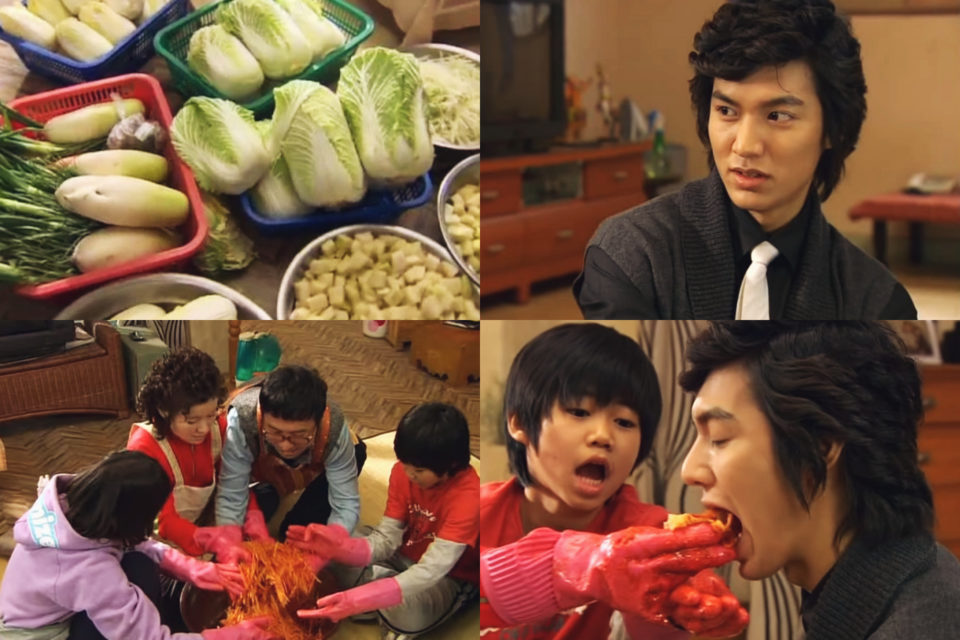Kimchi: The Versatile Dish that Adds Flavor to K-Dramas
Kimchi is Korea’s second-most important cultural asset, the first being the folk song “Arirang.” It is a cornerstone in Korean culture and a staple in K-dramas as well
History has it that, in Korea, kimchi was traditionally created during the winter months by fermenting vegetables and storing them in jars. As a result, the family’s female members formed a strong connection during the process. This is why perhaps kimjang, the tradition of preparing kimchi as a collective effort, is featured in K-dramas as a way to promote Korean culture while also fostering family bonds. Enjoy the following video from the popular variety show, Mr. House Husband, where the houseman says, “Kimchi must be done together.”
Kimchi (the marinated pickle) is typically served as a spicy accompaniment to a Korean meal. It’s a concoction of salted and fermented vegetables, including napa cabbage, Korean radish, spring onion and other condiments. It gained popularity with K-dramas introducing it to audiences all over the world, piquing our curiosity about its taste and flavors. Take for example the iconic scene from Boys Over Flowers, where Jan Di’s family leaves Jun Pyo, the archetypal rich brat of the Shinhwa family, amazed and intrigued while preparing kimchi together — it’s an act of pure enjoyment, fun and camaraderie, something Jun Pyo had never experienced in his daily life. In fact, after watching the series, I went to a Korean restaurant in my city and tried the kimchi ramyeon and tuna kimchi kimbap, and they tasted pretty good. In my opinion, kimchi is like the Korean counterpart to our Indian achaar (pickle).

During the Vietnam War, kimchi production rose to prominence as the Korean government had to feed its soldiers. And for Yi So-yeon, Korea’s first astronaut, the country’s scientists devised a unique, low-calorie, bacteria-free ‘space kimchi’ (unlike conventional kimchi, which requires bacteria for fermentation). Furthermore, the government developed multiple initiatives aimed at encouraging adult Korean adoptees to return to their homeland and know their roots.
One of these activities was learning how to make kimchi. Remember the episode from Run BTS, in which the K-pop superstars were pitted against one another in a kimchi-making challenge? Well, the actual purpose of the show (besides providing entertainment) was to establish kimchi as a hallmark of Korean food.
Kimchi can be consumed as it is, with rice, or be used in different Korean delicacies. It serves as a spicy addition to a variety of meals, including kimchi fried rice (김치볶음; kimchi bokkeumbap), kimchi pancake (김치전; kimchi jeon), and kimchi stew (김치찌개; kimchi jjigae). Park Joon-hwa, producer and director of the rom-com thriller Let’s Eat, explained that eating scenes are common in K-dramas because a lot happens over food – people have fun, they engage in fights, or even fall in love while eating. If you’ve seen Jin Yi’s kimchi jjigae recipe scene in the show, you know exactly what he meant.
Many of you might know about makjang dramas. For those who don’t, let me explain what the term means. A makjang drama is an exaggerated story with bizarre or unusual settings and scenes that are tough to comprehend. In a makjang drama, irregularity is usual. Awkward birth secrets, murders, mad revenge plans and more are some of the most popular themes. In this vein, the viral ‘kimchi slap’ from 2014’s Everybody Say Kimchi certainly qualifies as a makjang scene.
When Im Dong-joon’s (Won Ki-joon) ex-mother-in-law (Lee Hyo-choon) accuses him of destroying her daughter’s kimchi business, the two get into a heated argument, and the lady slaps him hard with the cabbage kimchi she was carrying in anger. While the scene looked quite hilarious, Won was in pain after the shot. In an interview with Radio Star, the actor revealed that the kimchi, seasoned and soaked in chili paste, gave him a severe headache and he had a hard time enduring the pain.
Kimchi is a language that the people of Korea use to communicate and connect while staying close to their culture, activities, daily lifestyles, entertainment, and everything in between. This marinated pickle, in my estimation, is a metaphor for the harmony and balance that symbolizes the Korean people’s ethos. It is a culture unto itself. I believe its diverse flavors, which keep changing with time, represent the malleable character of life and emotions. Perhaps this is why kimchi’s very adaptable nature lends itself to a variety of roles in Korean dramas.
Featuring Kang Daniel, Dreamcatcher, (G)I-DLE, Sunmi, P1Harmony, BIBI, Bang Yongguk, Holland, Victon's Hanse, Suran, Junny and more, get a nuanced understanding of the Korean music landscape with Rolling Stone India's K-Music Special issue. Buy your physical copy here.








